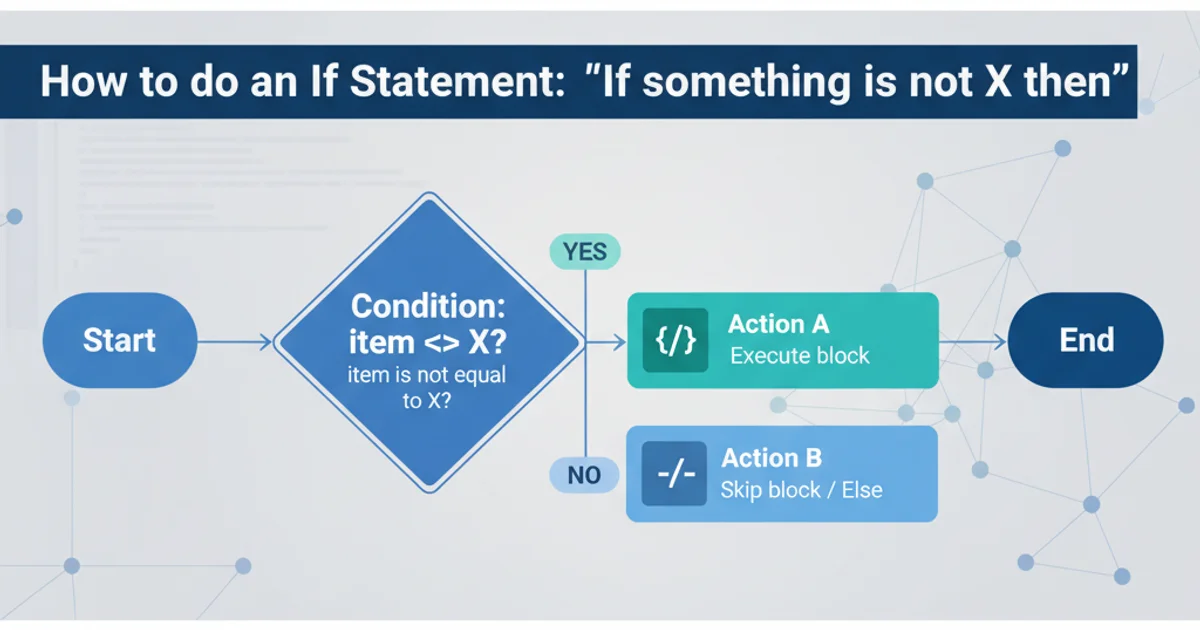How to do an If Statement that would be the equivalent to "If something is not X then"
Categories:
Mastering Negative Conditions: The 'If Not X Then' Equivalent in VB6

Explore various methods to implement 'If something is not X then' logic in VB6, covering best practices and common pitfalls for robust conditional statements.
In programming, conditional statements are fundamental for controlling program flow. Often, you need to execute code only when a certain condition is not met. While many modern languages offer direct 'not equal' operators, VB6 provides several ways to achieve the equivalent of 'If something is not X then'. This article will guide you through the most common and effective approaches, ensuring your VB6 applications handle negative conditions gracefully.
Understanding the 'Not Equal' Concept in VB6
The core idea behind 'If something is not X then' is to check for inequality. In VB6, the primary operator for 'not equal to' is <>. This operator directly translates to 'is not equal to'. When used within an If...Then statement, it allows you to specify actions that should occur when a variable or expression does not match a particular value.
Dim myVariable As String
myVariable = "Apple"
If myVariable <> "Orange" Then
MsgBox "The variable is not Orange."
End If
Dim myNumber As Integer
myNumber = 10
If myNumber <> 5 Then
MsgBox "The number is not 5."
End If
Basic usage of the <> (not equal) operator in VB6.
Using the Not Operator with Boolean Expressions
Another powerful way to express a negative condition is by using the Not logical operator. This operator inverts the truth value of a Boolean expression. If an expression is True, Not makes it False, and vice-versa. This is particularly useful when you have an existing condition that evaluates to True for the cases you want to exclude.
Dim isProcessed As Boolean
isProcessed = False
If Not isProcessed Then
MsgBox "Item has not been processed."
End If
Dim userName As String
userName = "Admin"
' Equivalent to: If userName <> "Guest" Then
If Not (userName = "Guest") Then
MsgBox "User is not a Guest."
End If
Applying the Not operator to boolean variables and expressions.
flowchart TD
A[Start]
B{Is Condition True?}
C[Execute Code for True]
D[Execute Code for False]
E[End]
A --> B
B -- "Yes (Condition is True)" --> C
B -- "No (Condition is False)" --> D
C --> E
D --> E
subgraph "If Not Condition Then"
F{Is Condition True?}
G[Execute Code for False]
H[Skip Code]
F -- "Yes (Condition is True)" --> H
F -- "No (Condition is False)" --> G
endFlowchart illustrating standard If-Then vs. If Not Condition-Then logic.
Handling Multiple Negative Conditions
When dealing with more complex scenarios where you need to check if a variable is not equal to any of several values, you can combine the <> operator with logical operators like And and Or. Remember to use parentheses to ensure correct evaluation order, especially when mixing And and Or.
Dim userRole As String
userRole = "Editor"
' If userRole is not "Admin" AND not "SuperUser"
If userRole <> "Admin" And userRole <> "SuperUser" Then
MsgBox "User is neither Admin nor SuperUser."
End If
Dim statusCode As Integer
statusCode = 200
' If statusCode is not 400 AND not 500
If Not (statusCode = 400 Or statusCode = 500) Then
MsgBox "Status code is not a client or server error."
End If
Combining negative conditions with And and Or operators.
Not (condition1 Or condition2) pattern. It often makes the intent clearer than condition1 <> value1 And condition2 <> value2.Best Practices and Common Pitfalls
While the methods above are straightforward, keep these points in mind for robust code:
- Null Values: Be cautious when comparing against
Null.Null <> "SomeValue"will always evaluate toNull, which is treated asFalsein anIfstatement. UseIsNull()for explicit checks. - Empty Strings: Differentiate between an empty string (
"") and aNullstring."" <> "SomeValue"works as expected, butNull <> "SomeValue"does not. - Case Sensitivity: String comparisons in VB6 are case-sensitive by default unless
Option Compare Textis set at the module level. If you need case-insensitive comparison, convert both sides to the same case (e.g.,UCase(myString) <> UCase("VALUE")). - Clarity: Choose the method that best expresses your intent. For simple inequality,
<>is usually best. For inverting a complex positive condition,Not (...)can be more readable.
Dim myString As Variant
myString = Null
' This will NOT execute the MsgBox because Null <> "Test" evaluates to Null (False)
If myString <> "Test" Then
MsgBox "This will not show if myString is Null."
End If
' Correct way to handle Null
If Not IsNull(myString) And myString <> "Test" Then
MsgBox "This will show if myString is not Null and not 'Test'."
End If
Dim caseSensitiveString As String
caseSensitiveString = "Hello"
' Case-sensitive comparison
If caseSensitiveString <> "hello" Then
MsgBox "Case sensitive: 'Hello' is not equal to 'hello'."
End If
' Case-insensitive comparison
If UCase(caseSensitiveString) <> UCase("hello") Then
MsgBox "Case insensitive: 'Hello' is equal to 'hello'."
Else
MsgBox "Case insensitive: 'Hello' is equal to 'hello'."
End If
Examples demonstrating Null handling and case sensitivity in VB6 comparisons.